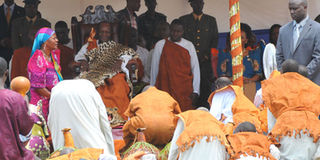Prime
How names of Buganda counties are ‘vanishing’ with modernity

Subjects prostrate before Kabaka Ronald Mutebi during the 2oth Coronation anniversary. Photo by Faiswal Kasirye
A week ago, Kabaka Ronald Mutebi II toured his counties of Bugerere and Kyaggwe. The memory of the tour is still fresh and many can probably easily locate these places. But would you locate them before the tour?
Bugerere and Kyaggwe are just two of the 20 counties of Buganda Kingdom, many of which are not readily identifiable by many. We know Bugerere as Kayunga and Kyaggwe as Mukono.
Dan Muliika, a former Katikkiro of Buganda Kingdom, says the government of Uganda, against the kingdom’s wish, changed the names of the counties.
“They changed the true names of our counties and instead popularised the names of towns. Mukono was just a town, Kalangala was also just a small town,” Muliika says.
Kalangala is now more known than Ssese, the original county in which it is found. In those days, Kampala was Kyaddondo, Luweero was Bulemeezi and Mityana was Ssingo.
Many of these old county names are now almost officially unknown, except, perhaps, in the Lands Office where they continue to appear on land titles.
Muliika, an enthusiast for the federal system of government, popularly known in Buganda as federo, sees this as a demonstration of the need for a federal system of government.
Under the federal arrangement, Muliika says, the central government would have no business “tampering” with local names of places but would confine itself to national business like defence and foreign affairs.
Political issues
Denis Walusimbi-Sengendo, the kingdom’s spokesperson, says the re-naming of the counties was political, “intended to exterminate the memory of those counties and weaken Buganda.”
Here, Walusimbi-Sengendo hints on the uneasy relationship between Buganda and Uganda, which dates back to the pre-independence days. Governments, especially Milton Obote’s, sought to dismantle as much as possible what the old kingdom stood for.
Kabaka Mutebi’s administration is now rebuilding. Walusimbi says the counties (masaza) were an integral part of the kingdom’s administrative structure which must be maintained.
At its founding, according to information on the kingdom’s website, Buganda only comprised of the counties of Busiro, Busujju, Kyaddondo and Mawokota, in addition to small portions of Ssingo and Bulemeezi counties.
At the height of its power, just before the British intervened in the 1890s, Buganda had expanded to 17 counties, having annexed more territory especially from Bunyoro.
The kingdom’s collaboration with the British colonialists won it more territory and in 1896 the counties of Buyaga and Bugangaizi were added from Bunyoro. These two counties would, two years after independence, vote in a referendum to return to Bunyoro.
Threats
More recently, the kingdom was threatened with losing more territory, when Bugerere and Buruli threatened to break away.
“Cultural leaders” cropped up in the two counties, the one in Buruli (Nakasongola) assuming the title of Isabaruuli and that in Bugerere (Kayunga) calling himself Ssabanyala.
This was at the height of tensions between the current government and the kingdom and the developments in the two counties were thought to have been instigated by the government.
The Kabaka was blocked from visiting both counties.
Relations between the two power centres changed dramatically for the better in July, however, following the signing of a Memorandum of Understanding to return to the kingdom part of the properties it demands from the central government.
The Kabaka’s recent tour of parts of Bugerere is further demonstration of the shift in relations between his kingdom and the government.
Bugerere was added to Buganda by one of Buganda’s illustrious fighters, Semei Kakungulu while Buruli was added, also from Bunyoro, after the Buganda Agreement of 1900.
The kingdom now rotates its functions in different counties, Walusimbi-Sengendo says, partly to popularise the counties.
Functions
The latest annual bulungibwansi (community service) functions were marked in Kyaggwe while the Kabaka will soon proceed to Butambala for the public health functions.
Another effort to popularise the counties is the annual masaza football competition.
Following the tension created by the blocking of the Kabaka’s visit to Buruli (Nakasongola) in 2007, the kingdom printed out the map of Buganda showing the counties of the kingdom and it is still on sale.
It is now a requirement, for instance, for those going for betrothal (popularly known as ‘introduction’) ceremonies to take a map of Buganda as one of the presents to the parents of the bride.
That way, it is hoped, most people will not be left in doubt as to where Kyaggwe, Kyaddondo and Bulemeezi are found.




